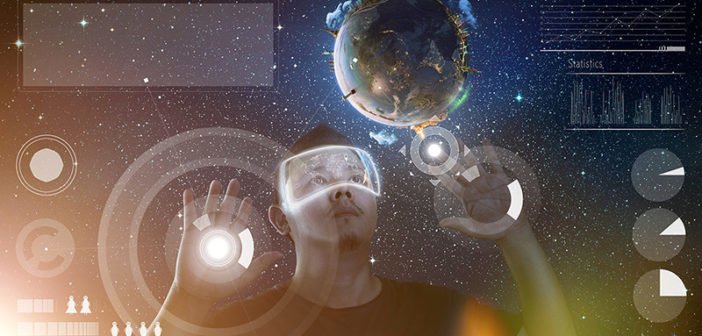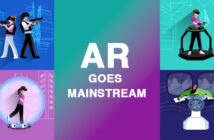We are almost one month into 2020. Perfect time to explore the new trends in VR technology that will define the new decade? Right?
Some numbers, first. By the end of this year, the global market size for VR and AR will reach 18.8 billion USD.
Consumer sectors (37.4%) will spend the most on AI and VR services, closely tailed by distribution and services (23.4%), and manufacturing and resources (19.3%) in 2020.
VR technology is motivating multiple industry segments across the world to invest. Here’s more on all that, and a lot more, with our take on the top VR trends to track in 2020.
VR Will Witness Adoption for Downsizing Large Stores
Home furnishing and décor brands are utilizing VR trends to give their walk-in customers a live experience of how the brand products will look in their homes. Brands like Wayfair have opened small physical stores in the major cities of the world.
The first Wayfair store opened in 2019 in Boston. It offers only a small selection of furniture and furnishings for their customers. However, at their AR and VR stations, experts are ready with new tech and equipment to give the consumers a taste of the Wayfair goodies in their virtual “real” homes.
VR allows customers to interact with the products, including adjusting their color, placement, and dimensions relative to the scaled version of their home living room, dining room, bedroom or bathroom.
Bigger brands are looking for smaller spaces to host physical stores! It is going to be a game-changer in terms of cost-effectiveness, tangibility and immersive experience in the current decade.
VR Will Deliver Immersive Education
The 2019 GESS Conference showcased the integration of VR in education and its benefits. VR breaks down boundaries and allows students to explore different subjects in an expert-designed environment.
Very soon, children will be able to explore riven formations, sea floors, and canyons by donning a pair of cool VR glasses. Lessons in geography, history, physics, chemistry, and environmental sciences will become real experiences.
Very recently, in a collaborative effort between Harvard University and Zhejiang University, students of the anthropology department explored the Pyramids of Giza in a VR-equipped classroom. Not only could they walk from one chamber to another, identify the Pharaohs, and priests, but also grab objects and move them around in the interactive learning environment.
Expect VR’s use in education to become more visible and mainstream in 2020.
VR will find its Way into Driving
Automobile manufacturers are not interested in driverless cars anymore. They are exploring new avenues to develop car-less driving with the help of VR. Digitization is changing the way we experience our surroundings. VR will allow people to test drive new models without actually seeing or touching any of them.
Dealers will no longer have to stock multiple new models. The cost of building and running a dealership will decrease drastically. Soon you will be able to test drive a Bugatti Chiron or an Audi RI without really leaving the dealer’s office.
Virtual Reality Will Take Travelers to Exotic Locations
Right now, leading travel and experience agencies are using VR to showcase travel destinations including the wonders of underwater flora and fauna off the coast of Andaman Islands that one can explore during scuba diving. Or, the thrill of canoeing across the Grand Canyon without really leaving the agency office.
In November 2019, Four Seasons Resort, Ko Olina, began offering a “VR Wellness Experience” to the patrons. It took the participants through calming oceans, deep space and beautiful caves. VR is taking experience-tourism to another level!
VR tourism is expanding the horizon of travel. We are not only going to explore the forests, seas, mountains and beaches around us but also the unfathomable depths of the oceans, go spelunking and explore the wonders of other galaxies without leaving our comfort zones in 2020.
VR-Enabled Native Advertising will replace print ads and TVCs
The VR market is set to reach a whopping 33.7 billion in 2022. This decade will see the emergence of several native VR advertising platforms.
VR advertising platforms like Vertebrae and Adverty, are derivatives of the VR market. These advertising platforms aim to work in partnership with Facebook, NFL, Huff Post, CBS and Fox News to bring immersive advertising to life.
Consider Coca-Cola’s Arctic Home campaign in partnership with the World Wildlife Fund. It moved hundreds of thousands of target viewers and evoked strong positive emotions by allowing viewers to interact with the virtual wildlife in a simulated environment. At the same time, the ad saved millions by not taking an entire filming crew out into the freezing arctic.
Easy adaptability, high-quality rendering, and cross-equipment compatibility make VR advertising cost-effective. Contrary to popular belief, AR and VR advertising is inexpensive than traditional TVC and print advertising. Expect higher industry spends in this category in 2020.
VR Will Take Us to Space and Beyond
VR will now enable people to explore life on the International Space Station. The Space Explorers: The ISS Experience is a 360-degree VR experience that gives everyone the chance to see how life is 250-miles above the earth’s surface.
This particular project will show kids and adults how the laws of physics hold in space and how it affects everyday tasks from drinking water to brushing. It is a brilliant outreach program by NASA that offers the viewers an accurate and incredible experience on-board the ISS.
Very soon, Time and Felix and Paul Studios will also bring the VR experience of spacewalking. It will change the way we perceive space and inspire millions.
VR to Catalyze Breakthroughs in Psychotherapy
Limbix, a startup that specializes in VR-based psycho-therapy, has shown that it is possible to treat anxiety and related disorders with the help of simulated environments. Limbix is only one of the hundreds of VR systems that are treating people and collecting real-time data on mental health issues.
Virtually Better, The Virtual Reality Medical Center and Psious are other VR systems currently being used for psychotherapeutic purposes. Very soon, with the help of VR therapists, people will be able to understand their phobias and triggers of anxiety and address them as well these VR trends will make a change.
Specially designed VR experiences can test, and treat people with specific phobias and anxiety disorders. For example, Richie’s Plank Experience places the user on a wooden plan 80-stories above ground. The virtual therapist encourages the user to walk on the plank and the system records the user’s responses throughout the session.
VR in combination with AR and AI is about to change the world. Imagine being ready at all times, be it a busted tire or preparing for a conference call with your seniors from overseas. The easy access to VR equipment and applications makes it possible for students to utilize its benefits without leaving the safety of their homes and classrooms.
It can not only help those with social anxiety and other mental health challenges, but it can help in the rehabilitation and therapy of individuals with serious PTSD.
VR can reinstate real life for the majority of the tech-savvy populace by the end of this decade.




